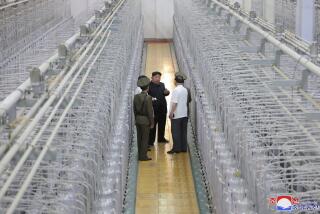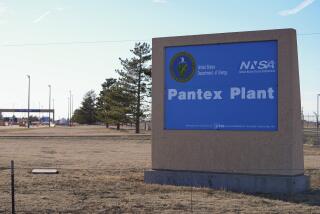Kentucky Site May Be Nuclear Weapon Grave
WASHINGTON — Federal nuclear regulators are investigating the possible burial of as much as 1,600 tons of nuclear weapon hardware on a 3,000-acre Energy Department site in Kentucky and whether the material poses a health risk to workers there.
The Energy Department would confirm only that “an underground classified storage site” at the facility near Paducah, Ky., is being investigated by its officials, the Pentagon and the Justice Department.
But a memorandum by a senior health and safety specialist at the Paducah Gaseous Diffusion Plant, located on the site, asks the Nuclear Regulatory Commission to investigate whether the material poses new health risks.
“I am . . . deeply concerned for the safety of personnel working [at the plant],” wrote Raymond C. Carroll, who works for the U.S. Enrichment Corp., which operates the plant.
Carroll, who has worked at the plant since 1992, said in the memo that he first learned of the nuclear weapon hardware Jan. 13 from his supervisor, who had learned of it only by chance recently.
The weapon material is thought to be within a 750-acre fenced-in part of the site but outside a smaller area, leased by USEC, that contains the uranium processing plant. Still, Carroll said in his memo that he was concerned about possible worker exposure.
“Some sanity needs to be put back into the system, and personnel safety needs to have commensurate emphasis with national security,” Carroll wrote.
Carroll, 57, who has been in nuclear health safety work for 30 years, declined to discuss the memo or the circumstances surrounding it.
It’s unclear what kind of weapon components might be buried at the site.
But the Paducah facility in the 1970s and ‘80s was charged with disassembling so-called secondary components of a variety of bombs and warheads, said one source familiar with the plant’s activities over the years.
Though some gold and other precious metals were set aside, leftover materials were supposed to be buried in classified disposal areas on the 3,000-acre site, the source said. Depending on the weapon design, the secondary triggers, which set off the primary explosion, could contain plutonium, highly enriched uranium, tritium and other radioactive material, said the source, who spoke on condition of anonymity.
USEC, a private company that processes uranium for use in commercial nuclear power plants, said in a statement that, “based on information available, we are aware of nothing that adversely impacts our employees.”
The Energy Department issued a report Thursday acknowledging that workers at the plant during the Cold War years were exposed to high levels of radiation and toxic chemicals.
More to Read
Sign up for Essential California
The most important California stories and recommendations in your inbox every morning.
You may occasionally receive promotional content from the Los Angeles Times.










